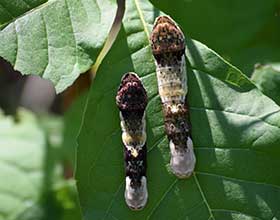 The common hoptree, Ptelea trifoliata, is the northernmost New World representative of the citrus, or rue, family of plants. It’s a relatively small tree, less than 20’ (6 m) tall and less than 10” (25 cm) trunk diameter, found in the woods understory or edges, so it is not highly conspicuous. But hoptree is of growing use in the landscaping trade, and both the tree itself and the insects it hosts are worth a second look.
The common hoptree, Ptelea trifoliata, is the northernmost New World representative of the citrus, or rue, family of plants. It’s a relatively small tree, less than 20’ (6 m) tall and less than 10” (25 cm) trunk diameter, found in the woods understory or edges, so it is not highly conspicuous. But hoptree is of growing use in the landscaping trade, and both the tree itself and the insects it hosts are worth a second look.
Hoptrees are recognizable from two key features. The first is the leaves, which, as the species name “trifoliata” indicates, are arranged in threes. That arrangement is reminiscent of poison ivy, but the form of the plant—a small tree for hoptree, a tangled mass or vine for poison ivy—readily differentiates them.
The second distinctive feature of a hoptree is its fruit. Hoptrees flower in early summer, and the flowers give rise to hanging clusters of papery, nearly circular fruits that each encase a single seed (technically, the fruits are samaras, as in elms, ashes, and maples). Those fruits provide the hoptree with its most common alternate name, the wafer ash. Hoptree wafers persist on the tree until they blow off in early winter.
Given the famously aromatic nature of cultivated citrus flowers and fruits, it should not be surprising that hoptrees, as members of the citrus family, are rich in chemicals. Hoptree bark has a long history of medicinal uses among Native Americans, both on its own and to potentiate the effectiveness of other medicines. The leaves have a bitter flavor that is thought to deter herbivory by deer and that provides yet a third name for the tree: stinking ash. The flowers emit aromas that are appealing to most people. Male and female flowers have slightly different complements of chemicals, so that, according to one study, the former are described as “light, fresh, and pleasant,” while the latter are “damp-earthy, spicy, and sweet.” And finally, the wafers also have a distinct chemical composition that confers a bitter flavor. Historically, those wafers have substituted for hops in beer brewing (hence the name hoptree), and some modern craft brewers are reintroducing that practice as a local specialty.
It’s probably those chemicals that serve to attract two distinctive insect visitors to the hoptree. While the tree itself might be confused for poison ivy, the specialist insects both are more interesting mimics. In biological mimicry, an animal has evolved a resemblance to some other element of its environment and gains some benefit from that resemblance. Often the model for mimicry is another animal; the viceroy butterfly, for example, resembles the more toxic monarch and thereby gains protection from predators. The hoptree insects offer a different version of mimicry.
One of those mimics is the giant swallowtail, Ohio’s largest butterfly. These butterflies only lay their eggs on hoptree and other plants of the rue family (there are only two native to Ohio, hoptree and prickly ash). Want to attract giant swallowtails to your yard? Plant a hoptree! The adult butterfly itself generally resembles other swallowtails–the yellow under-surface is similar to a tiger swallowtail, the black upper surface more like several dark swallowtail species. But it’s the caterpillar that’s the real mimic. Giant swallowtail caterpillars bear a striking resemblance to bird droppings! The smaller caterpillars especially sit exposed on hoptree leaf surfaces and look for all the world like a bird recently passed by. What predator would stop to feed on that!?
A second insect that specializes on hoptrees is the two-spotted treehopper (yes, treehoppers on hoptrees!). Treehoppers are small insects, maybe a quarter-inch (half-centimeter) in length, related to cicadas and leafhoppers. The species that lives on hoptrees completes its entire life cycle on the tree: females lay eggs under the bark, which overwinter and then emerge as juveniles in spring, which mature into adults; both the juveniles and the adults feed on sap (phloem, like aphids), and so they never need to leave the tree. Two-spotted treehoppers can occur in large numbers and often end up forming lines of insects along a branch. They really don’t have any protection from predators, other than their appearance: the thoracic shell in this species extends forward and forms a point, so that the insect on a small branch closely resembles a thorn. Indeed, the insects are sometimes called thornbugs. A row of treehoppers can present an intimidating sight, like a super-thorny rose cane.
So, keep an eye out for hoptrees. And when you do find one, look carefully among the leaves and branches. You never know what might be hiding in there!
Article and photo contributed by Dr. David L. Goldstein, Emeritus Professor, Department of Biological Sciences, Wright State University.
